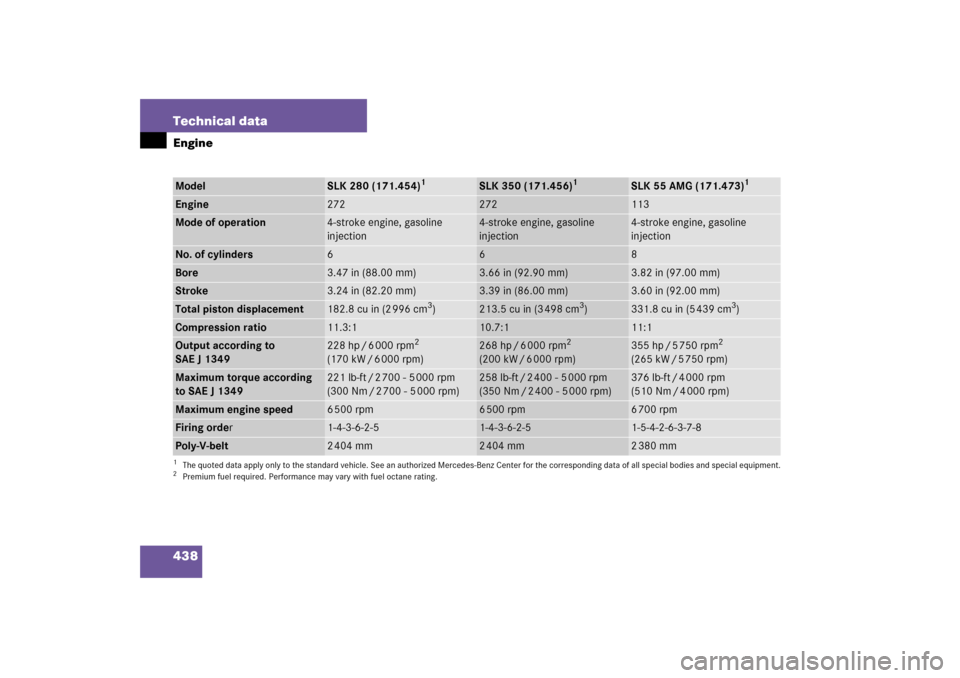Page 388 of 481
387 Practical hints
What to do if …
Display symbol
Display message
Possible cause/consequence
Possible solution
<
Seat belt system
Visit workshop
The seat belt system is malfunction-
ing.
�
Visit an authorized Mercedes-Benz Center
as soon as possible.
t
Function
Not available
This display appears if buttons
ort on the multifunction steer-
ing wheel is pressed and the vehicle
is not equipped with a telephone*.
Ê
Close trunk lid!
This message will appear whenever
the trunk lid is open.
�
Close the trunk lid.
W
Washer fluid
Top up
The fluid level in the windshield
washer fluid reservoir has dropped
below its minimum mark.
�
Add washer fluid (
�page 315).
Page 434 of 481
433 Technical data
Parts service
Warranty coverage
Identification labels
Layout of poly-V-belt drive
Engine
Rims and tires
Electrical system
Main Dimensions
Weights
Fuels, coolants, lubricants, etc.
Page 438 of 481
437 Technical data
Layout of poly-V-belt drive
�Layout of poly-V-belt drive
SLK 280, SLK 350
1Idler pulley
2Idler pulley
3Automatic belt tensioner
4Power steering pump
5Air conditioning compressor
6Crankshaft
7Coolant pump
8Generator (alternator)
SLK 55 AMG
1Automatic belt tensioner
2Power steering pump
3Air conditioning compressor
4Crankshaft
5Coolant pump
6Generator (alternator)
7Idler pulley
Page 439 of 481

438 Technical dataEngineModel
SLK 280 (171.454)
1
1The quoted data apply only to the standard vehicle. See an authorized Mercedes-Benz Center for the corresponding data of all special bodies and special equipment.
SLK 350 (171.456)
1
SLK 55 AMG (171.473)
1
Engine
272
272
113
Mode of operation
4-stroke engine, gasoline
injection
4-stroke engine, gasoline
injection
4-stroke engine, gasoline
injection
No. of cylinders
6
6
8
Bore
3.47 in (88.00 mm)
3.66 in (92.90 mm)
3.82 in (97.00 mm)
Stroke
3.24 in (82.20 mm)
3.39 in (86.00 mm)
3.60 in (92.00 mm)
Total piston displacement
182.8 cu in (2 996 cm
3)
213.5 cu in (3 498 cm
3)
331.8 cu in (5 439 cm
3)
Compression ratio
11.3:1
10.7:1
11:1
Output according to
SAE J 1349
228 hp / 6 000 rpm
2
(170 kW / 6 000 rpm)
268 hp / 6 000 rpm
2
(200 kW / 6 000 rpm)
2Premium fuel required. Performance may vary with fuel octane rating.
355 hp / 5 750 rpm
2
(265 kW / 5 750 rpm)
Maximum torque according
to SAE J 1349
221 lb-ft / 2 700 - 5 000 rpm
(300 Nm / 2 700 - 5 000 rpm)
258 lb-ft / 2 400 - 5 000 rpm
(350 Nm / 2 400 - 5 000 rpm)
376 lb-ft / 4 000 rpm
(510 Nm / 4 000 rpm)
Maximum engine speed
6500 rpm
6 500 rpm
6700 rpm
Firing order
1-4-3-6-2-5
1-4-3-6-2-5
1-5-4-2-6-3-7-8
Poly-V-belt
2404 mm
2 404 mm
2380 mm
Page 460 of 481

459 Technical terms
ETD
(E
mergency T
ensioning D
evice)
Device which deploys in certain frontal
and rear collisions exceeding the sys-
tem’s threshold to tighten the seat
belts. ->SRS
FSS PLUS (Canada vehicles)
(F
lexible S
ervice S
ystem PLUS)
Maintenance service indicator in the
multifunction display that informs the
driver when the next vehicle mainte-
nance service is due. FSS PLUS evalu-
ates engine temperature, oil level,
vehicle speed, engine speed, distance
driven and the time elapsed since your
last maintenance service, and calls for
the next maintenance service accord-
ingly.
GAWR
(G
ross A
xle W
eight R
ating)
(
�page 344)Gear range*
Number of gears which are available to
the automatic transmission for shifting.
The automatic gear shifting process
can be adapted to specific operating
conditions using the selector lever.
GPS
(G
lobal P
ositioning S
ystem)
Satellite-based system for relaying
geographic location information to and
from vehicles equipped with special re-
ceivers.
GVW
(G
ross V
ehicle W
eight)
(
�page 344)
GVWR
(Gross V
ehicle W
eight R
ating)
(
�page 345)Head-thorax air bag
Installed in the doors, these air bags
protect occupants during side impact
collisions exceeding a preset thresh-
old. Unlike normal side air bags,
head-thorax air bags are also designed
to provide protection for the head area.
Instrument cluster
The displays and indicator/warning
lamps in the driver’s field of vision, in-
cluding the tachometer, speedometer,
coolant temperature and fuel gauge.
Kickdown*
Depressing the accelerator past the
point of resistance shifts the automatic
transmission down to the lowest possi-
ble gear. This very quickly accelerates
the vehicle and should not be used for
normal acceleration needs.
Kilopascal (kPa)
(
�page 345)
Page 461 of 481

460 Technical termsLine of fall
The direct line an object moves down-
hill when influenced by the force of
gravity alone.
Locking knob
Button on the door which indicates
whether the door is locked or un-
locked. Pushing the locking knob down
on an individual door from inside locks
that door.
Maintenance System (U.S. vehicles)
Maintenance service indicator in the
multifunction display that informs the
driver when the next vehicle mainte-
nance service is due. The Maintenance
System in your vehicle tracks distance
driven and the time elapsed since your
last maintenance service, and calls for
the next maintenance service accord-
ingly.Maximum loaded vehicle weight
(
�page 345)
Maximum load rating
(�page 345)
Maximum tire inflation pressure
(�page 345)
Memory function*
Used to store three individual seat,
steering wheel and mirror positions.
MON
(Motor O
ctane N
umber)
The Motor Octane Number for gasoline
as determined by a standardized
method. It is an indication of a gaso-
line’s ability to resist undesired detona-
tion (knocking). The average of both
the MON (Motor Octane Number) and
->RON (Research Octane Number) is
posted at the pump, also known as
ANTI-KNOCK INDEX.Multifunction display
Two display fields in the instrument
cluster used to present information
provided by the control system.
Multifunction steering wheel
Steering wheel with buttons for operat-
ing the control system.
Normal occupant weight
(
�page 345)
Overspeed range
Engine speeds within the red marking
of the tachometer dial. Avoid this
engine speed range, as it may result in
serious engine damage that is not
covered by the Mercedes-Benz Limited
Warranty.
Poly-V-belt drive
Drives engine components (alternator,
AC compressor, etc.) from the engine.
Page 462 of 481

461 Technical terms
Power train
Collective term designating all compo-
nents used to generate and transmit
motive power to the drive axles, includ-
ing
�
Engine
�
Clutch/torque converter
�
Transmission
�
Transfer case
�
Drive shaft
�
Differential
�
Axle shafts/axles
Production options weight
(
�page 345)Program mode selector switch*
Used to switch the automatic transmis-
sion between standard operation (S)
and comfort operation (C).
Vehicles with steering wheel gearshift
control and manual shift program: in
addition toS andC (for regularS
or comfortC operation, see above),
you can useM for manual shift pro-
gram.
PSI
(P
ounds per s
quare i
nch)
(
�page 345)
Recommended tire inflation pressure
(�page 345)REST
(Residual engine heat utilization)
Feature that uses the engine heat
stored in the coolant to heat the vehi-
cle interior for a short time after the en-
gine has been turned off.
Restraint systems
Seat belts, belt tensioners, air bags
and child restraint systems. As inde-
pendent systems, their protective func-
tions complement one another.
Rim
(
�page 345)
Retractable hardtop
Hardtop that can be opened and closed
at the push of a button and stored in
the trunk.
Page 463 of 481

462 Technical termsRoll bar
Occupant protection system which
consists of tubular steel sheathed in
plastic.
RON
(R
esearch O
ctane N
umber)
The Research Octane Number for gaso-
line as determined by a standardized
method. It is an indication of a gaso-
line’s ability to resist undesired detona-
tion (knocking). The average of both
the ->MON (Motor Octane Number)
and RON (Research Octane Number) is
posted at the pump, also known as
ANTI-KNOCK INDEX.
Shift lock*
When the vehicle with automatic trans-
mission is parked, this lock prevents
the gear selector lever from being inad-
vertently moved out of positionP with-
out the SmartKey turned and the brake
pedal depressed.Sidewall
(
�page 345)
SRS
(Supplemental R
estraint S
ystem)
Seat belts, emergency tensioning
device and air bags. Though indepen-
dent systems, they are closely inter-
faced to provide effective occupant
protection.
Tele Aid system
(T
elematic A
larm I
dentification on
D
emand)
The Tele Aid system consists of three
types of response: automatic and man-
ual emergency, Roadside Assistance
and information. Tele Aid is initially ac-
tivated by completing a subscriber
agreement and placing an acquain-
tance call.
The Tele Aid system is operational pro-
vided that the vehicle’s battery is
charged, properly connected, not dam-
aged and cellular and GPS coverage is
available.Tightening torque
Force times lever arm (e.g. a lug
wrench) with which threaded fasteners
such as wheel bolts are tightened.
TIN
(T
ire I
dentification N
umber)
(
�page 346)
Tire load rating
(�page 346)
Tire ply composition and material used
(�page 346)
Tire speed rating
(�page 346)
Traction
(�page 346)
Tread
(�page 346)
Treadwear indicators
(�page 346)
Uniform Tire Quality Grading Standards
(�page 346)